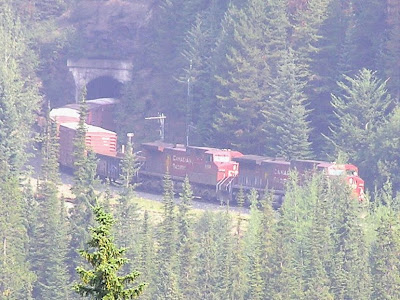Started in Mammoth Hot Springs, just inside the North Entrance. The Hot Springs are thermal features that bubble out of terraces of residue. Interesting colors in the residue indicating the work of heat-loving bacteria. One can climb up to the thermal features or look down on them from the highway going south.
The elevation at Mammoth Hot Springs is low enough that it is accessible year-around. In the 1880's the U.S. Army was given the job of policing Yellowstone. The Army Corps of Engineers also built the basis for today's roads.
 |
| Corps of Engineers Building at Fort Yellowstone |
Much of the fort built at Mammoth is preserved as the headquarters and residences for the National Park Service in Yellowstone. The substantial buildings indicate that Army duty at Yellowstone wasn't bad.
From Mammoth, we had a leisurely drive to Norris Junction, punctuated by stops at viewpoints and educational exhibits and by a most pleasant picnic. At Norris, we went up to the Norris Geysers, the hottest and oldest Geyser Basin in Yellowstone. It is a field that is more intimate than Old Faithful and its companions. Here the boardwalks over the thermally active areas allow one to get within a few feet of the geysers. For example, Steamboat Geyser is said to be the most powerful in the world, although its major, 300+ foot eruptions occur only every few years. But Steamboat bubbles with minor eruptions all the time - only 50 feet from the observation platform.
 |
| Steamboat Geyser on a Quiet Day |
Then it was time to leave Yellowstone, but we have learned that if you want to see elk, leave Yellowstone. Between Madison and the West Entrance, we saw a small herd of does and fawns feeding along the Madison River. The fawns are young enough that they still sport spots, although that may not show up in the photo below (hard to see when shooting into the sun).
 |
| Elk Fawn - yes, there are Spots |
 |
| Elk Herd Munching |
Along the way, we had one last look at the backside (West Side) of Grand Teton.
 |
| Grand Teton through the Haze along US 89. |














































